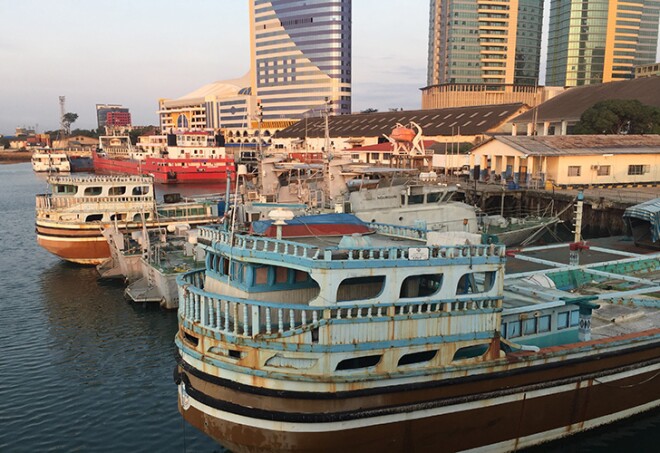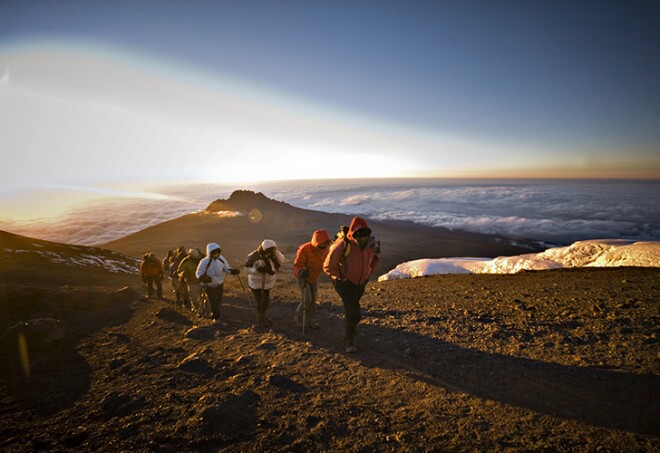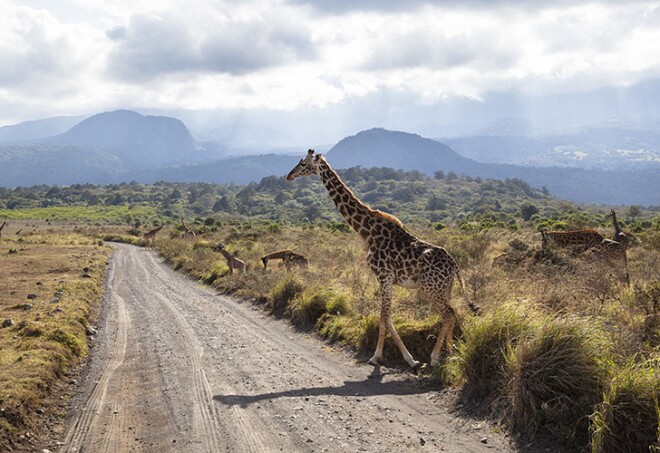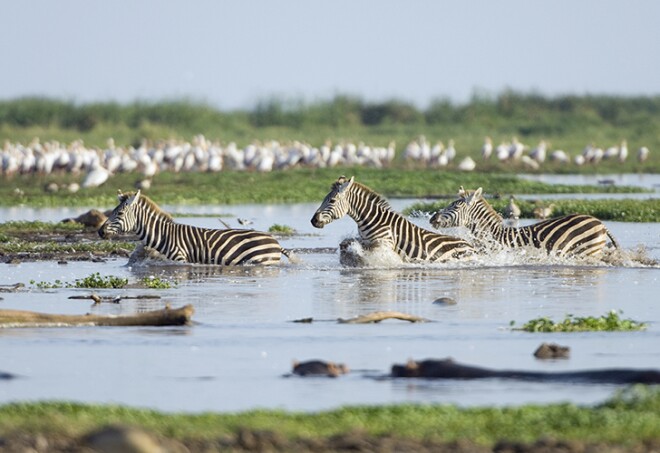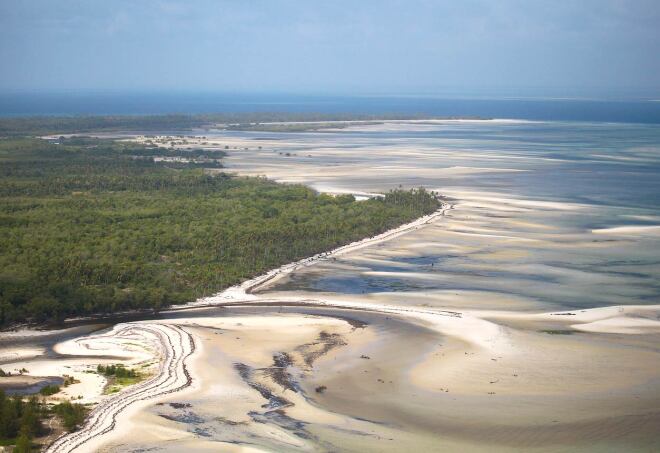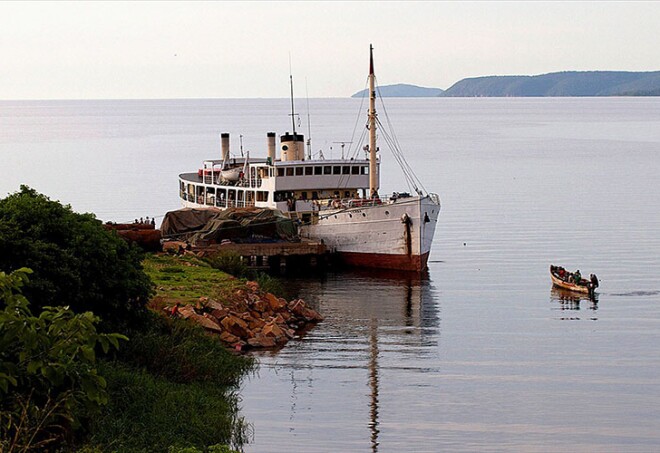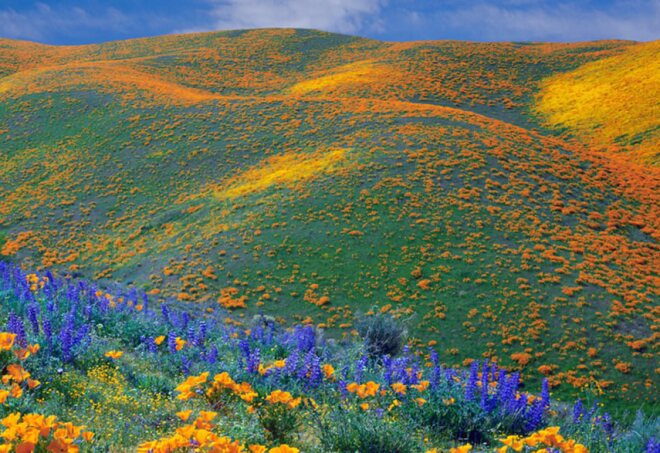The Best Places to Visit in Tanzania
Take a look through our recommendations for what to do and see in Tanzania and see if you can resist booking a trip. The beaches, the national parks, the forests, lodges, wildlife, and lakes of this extraordinarily rich nation are the stuff of travel dreams.
Sokoine Drive, Dar es Salaam, Tanzania
Sure, you can fly straight into Zanzibar, but where’s the fun in that? The Azam Marine ferry makes for a wonderful adventure from Dar es Salaam to Zanzibar, departing from the port in Tanzania’s capital four times a day. Passengers can sit out on deck as the catamaran edges away from the mainland, taking in the sea breeze, admiring the quaint little fishing boats bobbing about in the sunshine, and watching giant trawlers heading out into the glistening sea. The VIP experience is the way to go—VIP passengers are treated to reclining red-leather seats and a free coffee during the 90-minute journey. Suffer from seasickness? Beware: The water can be choppy in the afternoon, so opt for an early sailing instead. Advance booking is necessary.
Mount Kilimanjaro, Tanzania
Mount Kilimanjaro is a treasure of Tanzania and a popular attraction for tourists wanting to conquer Africa’s tallest mountain. Because of its fame and relatively easy ascent—if you don’t count the altitude sickness—this hike attracts more than 16,000 climbers a year. If you want to climb in relative peace, take the Northern Circuit detour, which avoids the busiest trails.
Ngorongoro Conservation Area, Tanzania
Move over, canvas safari tent; Tanzania has a new lodging option, this one in the form of a space-alien-looking dome. Set back from the famous Ngorongoro Crater and its plethora of lodges, the Highlands domes’ wild, remote, forest-edge location is one of the key selling points. The accommodations were custom-built to make it easy to take in incredible views. Asilia, the safari outfitter that owns these dwellings, prides itself on the authenticity of the experience, so trips to visit local Maasai communities are low-key and varied, with a different village visited each day. At more than 7,500 feet above sea level, evenings are chilly, but each dome tent is fitted with a high-output woodstove to keep guests cozy all night long.
About 40 miles west of Mount Kilimanjaro lies Mount Meru, a neat triangle of a mountain usually flanked by a blanket of cloud. The mountain’s within Arusha National Park, a peaceful haven for a variety of wildlife, including giraffes, leopards, and hyenas who slink around in the early hours. Treks up this 15,000-foot dormant volcano usually take three to four days, and a climb is a popular precursor for those planning to hike Kilimanjaro because it allows them to acclimatize to the altitude ahead of time. Treks begin at the park’s Momella Gate. At overnight stops in mountain huts along the route, the hiking guides regularly regale clients with stories of the wild animal encounters they’ve had in the park during their careers.
Matemwe, Tanzania
Fragrant spice tours, ancient architecture, beaches as white as the inside of a coconut: Zanzibar is the stuff of travel legends. One of the many idyllic beaches to choose from in Zanzibar is Matemwe, which has a laid-back, village charm to it. Local women harvest seaweed in the shallows, kids run and play along the sand, and tourists dip in and out of the smattering of beachfront restaurants and shacks serving Swahili cuisine. About an hour’s drive from Stone Town, Matemwe is a place of pure relaxation, where you can wade in the balmy Indian Ocean or sit on the perfectly pale sand under the shade of the palm trees. Should the novelty of lazing about wear thin, head for the One Ocean dive center, which offers snorkeling and scuba-diving trips off the shore.
Changuu Island, Tanzania
Changuu Island, also known as Prison Island, is about a 30-minute boat ride from Stone Town. The water around the island is crystal-clear and cerulean blue, which makes snorkeling here hard to resist, but a visit also lets you gain an understanding of a grim period of Zanzibar history. In 1860, the small island was used as a prison for disobedient slaves. By 1893, construction of an actual prison complex was completed, but instead of housing prisoners, it was used to quarantine yellow fever cases. Nowadays, the island is home to some endangered Aldabra giant tortoises, given to the island in 1919 by the British governor of the Seychelles. Some of those original tortoises are supposedly still alive here to this day!
Tourists visiting Tanzania usually spend a few days on safari, spotting lions and zebras from their 4x4 vehicles. But clever tourists go on to experience an equally thrilling marine safari off the coast of Pemba Island. Among the island’s several luxury resorts is Fundu Lagoon, a boutique beach hotel founded by British fashion and film designer Ellis Flyte. The property has its own diving facility, called Dive 710. The shallow coral lagoons, warm clear water, and unique locations like the Emerald Reef—an undersea garden of green-hued corals—make this region one of the best dive sites in the world. Divers off Pemba can expect to see fish of every color as well as sea turtles and rays.
Located about a 90-minute drive west of Arusha, Lake Manyara National Park may be one of Tanzania’s smallest safari parks, but the range of different landscapes and ecosystems here make it one of the most interesting. Along the escarpment, you’ll spot rock-climbing klipspringer antelopes, while warthogs, wildebeests, giraffes, and elephants enjoy the grasslands. During the wet season, thousands of flamingos flock to the huge alkaline lake, and throughout the year more than 300 species of birds can be sighted. It’s worth stopping by the hippo pond, where visitors can get out of their cars (which you can’t do elsewhere in the park) for a ground-level view of the huge beasts wallowing in the water, shading themselves from the intense sunshine.
Mafia Island, Pwani Region, Tanzania
The Mafia Archipelago (its name is said to come from the Arabic word morfiyeh, which means “archipelago”) consists of several islands and atolls, the largest of which is Mafia Island itself. Mafia Island is a nearly undiscovered alternative to Zanzibar, with similar picture-perfect beaches and diverse marine life, but without the crowds of tourists. Its history can be traced back to the 8th century, when boats would stop to refuel and repair along the lucrative coastal trade route. This legacy is evident in the crumbling ruins of a former town called Kua, which include a mosque and unexcavated Chinese and Persian pottery. South of the island is the submerged town of Kisimani Mafia, which was destroyed and submerged by an 1872 cyclone and has yet to be fully excavated. A protected marine preserve encompasses the islands and reefs, making this region is a diver’s paradise. Mafia Island Lodge offers makuti (similar to thatch-roofed) rooms with sea views, plus fishing, biking, walking, diving, and snorkeling, as well as historical and cultural tours.
Iringa, Tanzania
The largest of Tanzania’s state-administrated national parks, Ruaha is home to the Great Ruaha River, imposing baobab trees, and one of the greatest populations of elephants in any African park. It has few lodges and therefore few tourists. It is also wilder than its close neighbor, the Selous Game Reserve, and boasts a truly authentic safari experience. Night driving is not permitted, nor are walking safaris, generally, due to the large number of elephants here. But hidden away on the Jongomero River in the remote southern area of the park is the Jongomero Camp, which is both fantastically luxurious as well as truly one with its surroundings. It is possibly the best camp in the whole of Tanzania, and its guides are second to none. In addition to the breathtaking campsite itself, it offers “fly-camping” trips on which the adventurous traveler can spend the night under the stars.
Kigoma Region, Tanzania
Gombe Stream National Park is home to the Gombe Stream Research Center. Founded in 1967, it is a living laboratory, and a testament to the pioneering research and conservation efforts conducted by Jane Goodall on behalf of the park’s chimpanzee population. The smallest of Tanzania’s national parks, Gombe is set on the glistening shores of Lake Tangyanika and is surrounded by ancient forest and cavernous valleys. To embark on an unforgettable, several-day chimp-tracking experience, you get to the park via motorboat from Kigoma or take a local lake-taxi. A stay at Gombe Forest Lodge provides a lush, intimate haven to rest weary feet after a morning’s trek: Enjoy a dip in the crystal-clear lake, and a sundowner around the fire beneath the brilliant backdrop of stars and mystical shadowy trees.
Mwanza, Tanzania
To visit Mwanza is to head off the traditional tourist trail of Tanzania. Here, on the coast of Lake Victoria, commercial ships fish for Nile perch and sardines that will be sold across Africa; every year Tanzanians flock to Mwanza for work opportunities. Explore this thriving and interesting city with a stop at the Mwaloni fish market (where you’ll also find produce brought in from villages around the lake) and take in the pretty views of Lake Victoria. Bismarck Rock, a tall boulder balancing atop a jumble of rocks out in the lake, can be visited en route to the ferry terminal. Ferries carry passengers across the lake to Bukoba and points along the shore. From Mwanza, it’s also possible to hop a train across the country to Dar es Salaam, but be warned—it’s regularly delayed for as many as 12 hours.
Singita Grumeti, Mara River, Serengeti 31623, Tanzania
The Singita Mara River Tented Camp sits amidst the 98,000 acres of northern Tanzania’s Lamai. It is one of the few permanent sites for travelers in this triangle of land sandwiched between the Maasai Mara National Reserve in Kenya and the Mara River in the south. Singita, however, still mimics the adventurous vibe of a mobile safari: Its tents are outfitted with everyday African objects that have been reimagined by local craftspeople. For example, decorative wire baskets mimic the shape and design of the ones traditionally used for sorting grain, and textiles with Maasai-inspired patterns in red, black, and blue add interest to the predominantly neutral interiors. And everything, from the pool pump to the cordless hair dryers, runs on the latest renewable-energy technology (the camp is completely off the grid).
Lake Natron
Inhospitable might not sound like the most appealing word to describe a tourist destination, but it’s precisely Lake Natron’s inhospitable nature that makes it the perfect spot for viewing flamingos. The elegant pale-pink birds flock here by the thousands each year, attracted by the safe and secure alkaline lake as a place to make their nests. It’s safe because of the lack of predators, who can’t survive in this searing, hostile environment when the only water to drink is both hot and high in pH. The scenery here is otherworldly: the lake’s cracked, red surface; the surrounding tall and barren mountains. Rather disturbingly, but also kind of fascinatingly, mummified birds can be found along the shoreline, calcified by the lake over hundreds of years.
Dar es Salaam, Tanzania
In the heart of Dar es Salaam, the Mwenge Woodcarvers Market is filled with artisans hard at work creating beautiful and unique items. Wooden masks are particularly popular, but you’ll also find treasures in craft shops selling a whole range of goods from fabrics to sandals, beaded necklaces, and more. Unlike some tourist markets around the world, the sellers here tend not to hassle customers. They’ll encourage you to come into their store, but you won’t be pestered to buy anything. Don’t forget to bargain and shop around at the market, as prices are negotiable and you may find a similar item for half the price at another stall.
Arusha Region, Tanzania
Located along the road leading into the Serengeti National Park, the tiny mountain village of Monduli Juu hosts the Red Market every Saturday. Local Maasai people descend on the town from the outlying region, dressed in their red-tartan blankets and carrying goods to sell and barter with for the vegetables, clothes, soap, live animals, and cooking oil on sale here. This is very much a vital market, not a show for tourists. Goat auctions take place on the soccer field, and women lead donkeys from the market laden down with heavy sacks of rice. A dala dala (minibus) from Arusha is recommended: The journey takes about an hour, is affordable, and passes through a lush green forest.
Kigoma Region, Tanzania
The historic MV Liemba is the oldest functioning ferry in the world, and a voyage down Tanzania’s Lake Tanganyika on this landmark is a colorful experience. Your fellow passengers will include traders loading and unloading cargo (anything from pineapples to flip-flops) and locals using the ferry for transport. On the southbound journey, the boat departs from the town of Kigoma and travels 300 miles to Zambia, where its makes its first port of call on land. But in between those two stops, while still on the water, travelers can transfer to smaller ships in order to reach places like Lagosa (a jumping-off point for the Mahale Mountains National Park) or the peaceful beach area of Kipili.

M & M Valledor/age fotostock
Zanzibar, Tanzania
As idyllic a tourist destination as Zanzibar is now, its history is undeniably dark. At the height of the slave trade in the 18th and 19th centuries, some 50,000 people were brought to Zanzibar each year, brutally removed from their homes in West Africa and made either to work on the coconut and clove plantations here or sold off at the market to buyers from around the world. A tour of the original site of the slave market (on whose site now stands an Anglican cathedral, once a building project for freed slaves and now a memoriam with exhibits) is an important reminder of this ugly time. Visiting the dim and suffocating underground chambers to see where human beings were bound and held in chains is chilling.
DC Kitulo, Makete, Tanzania
Referred to by locals as Bustani ya Mungu—literally, “the Garden of God"—this national park is a botanist’s delight, bursting with the colorful orchids, lobelias, and lilies that thrive in the fertile volcanic soil. This veritable Serengeti of flowers is also a bird- or butterfly-watcher’s paradise, with many endemic species swooping and fluttering amid the open and fertile grasslands. The plateau is accessible by 4x4 from Mbeya. Follow one of the hiking trails along the impossibly beautiful rolling plains or attempt a hill climb in the shadow of the looming peaks of the Kipengere, Poroto, and Livingstone mountains. The best time to visit is during the blooming season between October and April.
Arusha, Tanzania
Shanga, a nonprofit, employs more than 70 people with disabilities to fabricate beautiful handmade products from recycled materials. The range of skilled artistry here is truly impressive: The team creates paintings, woven rugs, handblown glasses, and intricately beaded jewelry. Visitors can join a tour of the workshop to see all this activity in person before stopping in at the store to pick up some special souvenirs. It’s an uplifting place and provides much-needed employment and care for these individuals. Since the idyllic location is at the Arusha Coffee Lodge, sticking around for lunch at the on-site café is a must.

